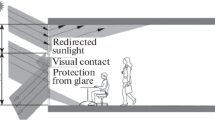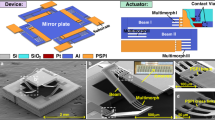Abstract
Energy saving potentials of micromirror arrays in active windows for smart personal environments (SPE) are studied. Such systems enable large area daylight guiding in buildings by application of electrostatically actuated micromirror arrays inside the noble gas or vacuum spacer between the panes of insulation glazings. The working principle in winter and summer scenarii is described. An alternative fabrication process for micromirror arrays, called transfer printing, is presented. For the first time we succeeded in fabricating micromirror arrays applying this novel transfer print.
Access provided by Autonomous University of Puebla. Download conference paper PDF
Similar content being viewed by others
Keywords
- Active windows
- Smart personal environments
- Micromirror
- Micromirror arrays
- Energy saving
- Transfer printing
1 Introduction
Advances in micro-electromechanical system (MEMS) technology lead to increasingly more powerful MEMS-based sensors and actuators. It is accompanied by a reduction in size and average cost of these devices. The broad availability of low-cost sensors and actuators allows the creation of new network systems operating in the background and improving daily life without being noticed by the user. Such systems work autonomously based on data collected by sensors, programs or learned rules, and change the environment by actuators. These systems are referred to as smart systems [1, 2]. By tailoring the system performance to individual preferences or medical needs, these systems can be personalized. Therefore, such a system is called smart personal environment (SPE). The SPE described in this paper, the active window, enables large area guiding of daylight in buildings by use of a MEMS technology, namely electrostatically actuated micromirror arrays [3]. They are placed in between the interspace of two window panes to protect them from external influences. The functional principle of the micromirror arrays and the active window is described below.
2 Active Windows
An active window is a SPE that uses electrostatically actuated micromirror arrays allows large-area daylight guiding in buildings. Such a micromirror array comprises several hundred thousand mirrors that can be actuated simultaneously. It is the smallest light-guiding unit of an activewindow which itself consists of several independently actuable micromirror arrays. This segmentation allows for very flexible light-steering that excels any conventional daylight-guiding system on the market. Enabling the system to tailor the ambience of the room to specific situations in an unprecedented way, the micromirror array segments of the active window provide various possibilities to block or guide light. These diverse possibilities require a SPE to utilize the full potential of such a active window. An example of such a SPE is depicted in Fig. 52.1. Sensors for temperature, light intensity, sun position, health-care and motion detection deliver the data to the networked control unit that manages the active window.
Active windows improve the energy efficiency of buildings in several ways: Heat control (protection/input) thereby reducing the load on air-conditionings, support of heating units and reduction of the need of artificial light. In order to illustrate this, two scenarii are considered in the following.
2.1 Summer Scenario
The sunlight is blocked by the major part of the active window, thus keeping the room cool while the input of natural light can be maintained by opening some arrays in the upper part of the active window guiding light to the ceiling. The use of artificial light can be reduced resulting in additional energy saving and an improvement of the room atmosphere. In addition it has been proven that the presence of natural light has a positive influence on human physiology.
2.2 Winter Scenario
Light incidence is maximized to use the sunlight as a heating source while some micromirror arrays can be closed which avoids glaring people inside the room. Keeping the amount of natural light high in winter is also desirable for the aforementioned reasons. In addition the SPE can improve the room climate by monitoring the presence of people and their activities. An empty room can be exclusively optimized under energy saving aspects until a person enters. Then the human demands stand in the foreground of the automatic control.
A further aspect in favor of such a system is a high life-time, since nowadays windows are expected to last at least 30 years. This is achieved by placing the micromirror arrays in the space between the regular insulation or vacuum panes. The micromirrors themselves are long-term stable due to the well-known advantage of miniaturization: downscaling causes a change in the influence of fundamental forces [4]. Furthermore thin film technology requires very little resources in terms of required material. That makes the active window saving resources in comparison to e.g. macroscopic lamella systems. Active windows consume very little energy due to the electrostatic actuation principle of the micromirrors [5, 6]. A life cycle assessment of the micromirror arrays in comparison with an optimized conventional slat blind system has shown that the micromirror arrays require less primary energy [7].
3 Fabrication Method
The crucial point in designing a MEMS-based daylight guiding system that can compete with conventional systems on the market is to find a low-cost fabrication process. This challenge does not only involve the use of low-cost materials but also a reduction of the process steps and controllable processes compatible with standard production lines available in industry. Another big issue is the fact that the windows have not to be produced in a cleanroom environment which is necessary for the micromirror array fabrication. By separating micromirror and window production, introduction of the system to the market will be facilitated. To this end we propose a novel fabrication method for micromirror arrays called transfer printing.
This method involves transferring a layer stack from a carrier substrate to a target substrate. In the first step the layer stack is produced on the carrier. The carrier with the layer stack on it is then ‘glued’ to the glass. After hardening of the glue the carrier is removed leaving the layer stack on the target substrate [8].
The transfer printing process for the micromirror arrays is shown in Fig. 52.2. In the first step an aluminum layer is deposited on the carrier substrate. In the following a photolithography step creates the etch mask. Then wet etching is carried out; mirrors and electrical interconnections are formed. The sacrificial layer is deposited by spin coating and structured by photolithography (a). Then a diluted ultraviolet (UV) curable hybrid polymer (Ormocomp) is applied as ‘glue’ by spin-coating. Finally the whole layer stack is transferred to the target substrate, an ITO glass (b). After hardening the resist the carrier substrate is pulled off (c) and the layer stack remains on the ITO glass (d). This is possible due to the different adhesion properties of the materials. By removing the sacrificial layer the mirrors can be released (e).
Transfer print process for micromirror arrays: Deposition of a layer stack containing micromirrors and a sacrificial layer onto a Si-substrate (a), application of an UV-curable material (glue) and joining with the ITO glass (b), hardening of glue and removal of carrier substrate (c), transfer of the printed structure (d), release of the micromirror by removal of sacrificial layer (e)
4 Results
We were able to produce a micromirror layer stack and transfer it from a silicon wafer to ITO glass by using Ormocomp as a transfer medium. To ensure a successful transfer print of the whole layer stack the adhesion properties of the utilized materials had to be adjusted. This has been achieved by applying an anti-sticking FDTS (1H,1H,2H,2H-Perfluorodecyltrichlorosilane) layer in order to reduce the adhesion between the silicon wafer and the mirror layer. Figure 52.3 shows the first result of transfer printed micromirror structures.
Bright-field (left) and transmission (right) photomicrographs of transfer printed micromirror structures before release. The rectangles are the moveable mirror parts connected by conducting lines from left to right. The separations between the mirrors were created by wet etching causing minor transmission
5 Outlook
The transfer print method is a very promising process to separate the production of the micromirrors from that of the windows. In future more investigations on the applicability on large areas (i.e. window size and larger) are required. This will involve further process optimizations and application of large-area processes (e. g. spray coating).
References
Cook DJ, Das SK (2007) Pervasive Mob Comput 3:53
Nakashima H (Hrsg), Aghajan H (Hrsg), Augusto JC (eds) (2010) Handbook of ambient intelligence and smart environments, Springer US, Boston, p 1
Hillmer H, Schmid J, Stadler I Micromirror array. EP 1700152 B1; US 7,677,742 B2
Hillmer H, Daleiden J, Prott C, Römer F, Irmer S, Rangelov V, Tarraf A, Schüler S, Strassner M (2002) Appl Phys B Lasers Opt 75:3
Jäkel A, Li Q, Viereck V, Hillmer H (2011) In: Voß A (ed) Nanotechnology and energy. Pan Stanford Publishing, Singapore
Hillmer H et al (2014) Proceedings of the GlassCon 2014, Philadelphia, USA 7–10 July 2014
Viereck V et al (2011) Proceedings of the Solar World Congress 2011
Bergmair I et al (2011) Nanotechnology 22:325301
Acknowledgments
The authors acknowledge funding by the European Union’s 7th Framework Programme for research, technological development and demonstration under grant agreement no. 314578 MEM4WIN (www.mem4win.org).
Author information
Authors and Affiliations
Corresponding author
Editor information
Editors and Affiliations
Rights and permissions
Copyright information
© 2015 Springer Science+Business Media Dordrecht
About this paper
Cite this paper
Tatzel, A. et al. (2015). Micromirror Arrays for Smart Personal Environments. In: Petkov, P., Tsiulyanu, D., Kulisch, W., Popov, C. (eds) Nanoscience Advances in CBRN Agents Detection, Information and Energy Security. NATO Science for Peace and Security Series A: Chemistry and Biology. Springer, Dordrecht. https://doi.org/10.1007/978-94-017-9697-2_52
Download citation
DOI: https://doi.org/10.1007/978-94-017-9697-2_52
Published:
Publisher Name: Springer, Dordrecht
Print ISBN: 978-94-017-9696-5
Online ISBN: 978-94-017-9697-2
eBook Packages: Biomedical and Life SciencesBiomedical and Life Sciences (R0)







